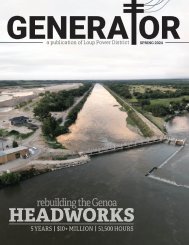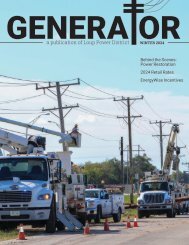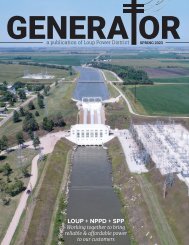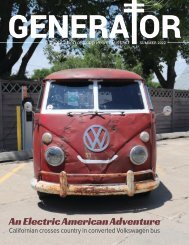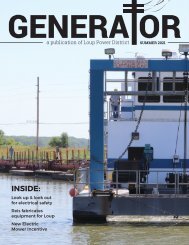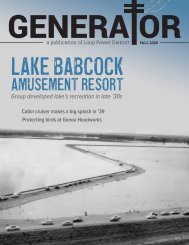Generator — Summer 2023
Learn about the Columbus Public Power Building and a building restoration project in Creston.
Learn about the Columbus Public Power Building and a building restoration project in Creston.
Create successful ePaper yourself
Turn your PDF publications into a flip-book with our unique Google optimized e-Paper software.
Top left: The state of the former<br />
Citizens State Bank before restoration<br />
work.<br />
Top: The Vault on Main owner Jamie<br />
Olmer talking about her project at a<br />
Community Builders meeting in March.<br />
Left: One of the first projects Olmer<br />
tackled was replacing the roof of the<br />
building.<br />
CITIZENS STATE BANK HISTORY<br />
Citizens State Bank was established<br />
in 1898. It grew rapidly and broke<br />
ground for a new building in 1920,<br />
holding an open house in 1921.<br />
The new bank was “one of the<br />
most modern and up-to-date bank<br />
buildings in this part of Nebraska,”<br />
according to the Creston Statesman.<br />
It featured mahogany and marble<br />
throughout its interior.<br />
The bank also featured a terra<br />
cotta exterior. By the 1920s, terra<br />
cotta was becoming more and more<br />
popular with architects because<br />
it was fireproof, economical, and<br />
lightweight. It was also easier and<br />
cheaper than carving stone.<br />
But the bank’s opulence and<br />
customers could not save it from the<br />
Great Depression and it closed in 1931.<br />
The bank continued to own the<br />
building until 1940 when it was sold<br />
by public auction to the Village of<br />
Creston for $102.50. It had a variety of<br />
uses until 1946 when it was purchased<br />
by a local family and turned into a<br />
meat locker. Farmers Cooperative Oil<br />
Company bought the building in 1964<br />
and used it for feed storage. Korth<br />
bought it in 2005 along with some<br />
adjoining buildings. It was unused and<br />
empty.<br />
NATIONAL REGISTER<br />
Right after buying the building,<br />
Olmer began steps to get it listed<br />
on the National Register of Historic<br />
Places.<br />
She visited the Nebraska State<br />
Historical Society and the State<br />
Historic Preservation Office (SHPO).<br />
Olmer explained that she was trying<br />
to dig up information on a building in<br />
a really small town. A SHPO employee<br />
there said they had an inventory of<br />
historically significant buildings<br />
throughout the state and they may<br />
have information.<br />
“Not knowing how rare and unique<br />
of a building this really was, I was<br />
sure they would not have a file on it,”<br />
Olmer said. “I stressed that this was a<br />
building in a very small town.”<br />
But as soon as she said “Creston”<br />
she learned about the significance of<br />
her small-town building.<br />
“The wedding cake?” the employee<br />
exclaimed and got the attention of<br />
everyone in the office who wanted to<br />
know her plans for the building.<br />
Olmer learned that the bank<br />
was designed by famous architect<br />
Frederick W. Clarke of Omaha.<br />
“There are plenty of buildings clad<br />
in terra cotta, but this one has two full<br />
sides, an enormous amount of detail,<br />
and color,” Olmer said.<br />
Most other terra cotta buildings<br />
in the state, such as Union Station<br />
(now Durham Museum) in Omaha are<br />
monotone. The Creston bank is mostly<br />
white, but with striking color accents.<br />
The façade features colorful lions’<br />
heads and floral swags. A large arch<br />
and columns flank the front door.<br />
“The details for the lions and the eagle<br />
are just amazing,” Olmer said.<br />
RESTORATION<br />
In 2020, the Covid-19 pandemic<br />
gave Olmer the extra time to begin<br />
restoring the building.<br />
The obvious first step was a new<br />
roof which involved replacing the<br />
north wall of the building. Then came<br />
the fun stuff <strong>—</strong> tearing out 18 inches<br />
of cement and filler on top of the<br />
original floor that was put in for the<br />
meat locker.<br />
SUMMER <strong>2023</strong> | 5



